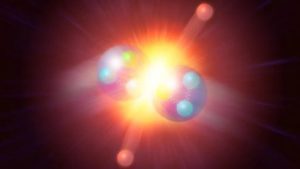Oxygen-28 May Challenge A Fundamental Law Of Physics
After scientists created oxygen-28 in the lab, it almost immediately degraded, baffling physicists around the world

For the first time, scientists have created oxygen-28, a rare oxygen isotope that has 12 more neutrons than oxygen-16, the most common form of oxygen on the planet.
This newly created “heavy” oxygen isotope has the highest number of neutrons ever seen in an oxygen atom and was expected to be ultrastable and last virtually forever.
Instead, however, it degraded amazingly quickly — a finding that challenges our understanding of the strong nuclear force, which binds the fundamental particles of matter, such as protons and neutrons, to form larger particles in an atom’s nucleus.
“It opens a very, very big fundamental question about nature’s strongest interaction, the nuclear strong force,” Rituparna Kanungo, a physicist at Saint Mary’s University in Canada who was not involved with the experiment, told New Scientist.
To create oxygen-28, a team led by researchers at the Tokyo Institute of Technology blasted a beam of fluorine-29 — an isotope that has nine protons — at a liquid-hydrogen target at the Riken RI Beam Factory in Wako, Japan.
Upon impact, both the hydrogen and the fluorine-29 lost a proton, which created an entirely new molecule of oxygen-28, according to the study, published Aug. 30 in the journal Nature.
Under the Standard Model, the leading theory of particle physics, particles should be stable if the shells in an atom’s nucleus are filled with certain numbers of protons and neutrons that are known as “magic” numbers.
Oxygen-28 contains 20 neutrons and eight protons, both of which are magic numbers, suggesting that the molecule should have been supremely stable or “doubly magic.” But that was not the case.
During the experiment, the oxygen-28 molecule decayed within a zeptosecond, or a trillionth of a billionth of a second. In fact, its presence was only confirmed by the products it left behind when it decayed: oxygen-24 and four neutrons.
“I was surprised,” Takashi Nakamura, a physicist at the Tokyo Institute of Technology and co-author of the study, told Nature. “Personally, I thought it was doubly magic. But this is what nature says.”
Though the experiment has not yet been replicated, the findings of this study suggest that the current list of magic numbers may not tell the full story of whether molecules are stable.
In a separate case, scientists in 2009 showed that an oxygen-24 isotope behaved as though it were doubly magic, even though it did not have a magic number of protons and neutrons.
The new study could pave the way for future research that may provide more clues about the mysterious forces gluing particles together in an atom’s nucleus, according to Michael Thoennessen, a professor of physics at Michigan State University and co-author of the study.
“I think the results of the experiments demonstrate the importance of studying these exotic nuclei along and beyond the limit of existence,” he told Live Science in an email.
“We still do not fully know what binds neutrons and protons together to form nuclei. Exploring these extremes test the foundations of the nuclear models.”
yogaesoteric
October 9, 2023
